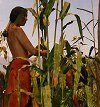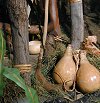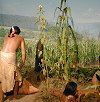A Guide to THE THREE SISTERS Diorama
Click on any image to see a close-up view of that part of the diorama.ACTIVITIES
 Iroquois corn at this 'green corn' stage is similar to our sweet corn and is ready to eat. The Iroquois used some of the crop at Green Corn Festival time, but most was left to ripen and was harvested in the fall. Ripe corn was dried and stored for winter use.
Iroquois corn at this 'green corn' stage is similar to our sweet corn and is ready to eat. The Iroquois used some of the crop at Green Corn Festival time, but most was left to ripen and was harvested in the fall. Ripe corn was dried and stored for winter use.
The silk on the ear of corn in the photo indicates that this ear is nearly ready to pick as green corn, but wait another day or two until the silk becomes a little drier and darker brown.
 Corn, beans and squash were commonly planted together in the same 'hill'. After the corn plants are growing, soil is piled up around their stalks to help keep them upright in the wind. Women did the farming, assisted by children, and at harvest time, by old men. Weeding was important to help the crops thrive and to keep the forest from encroaching into the fields.
Corn, beans and squash were commonly planted together in the same 'hill'. After the corn plants are growing, soil is piled up around their stalks to help keep them upright in the wind. Women did the farming, assisted by children, and at harvest time, by old men. Weeding was important to help the crops thrive and to keep the forest from encroaching into the fields.
 The tool with the long handle and curved blade is a replica of one described in the 1620s, as a wooden hoe used in cultivation. It was pictured in a French missionary's report in 1685. It's hard to imagine how it works. It is commonly believed that the Iroquois used the shoulder blades of deer as hoes.
The tool with the long handle and curved blade is a replica of one described in the 1620s, as a wooden hoe used in cultivation. It was pictured in a French missionary's report in 1685. It's hard to imagine how it works. It is commonly believed that the Iroquois used the shoulder blades of deer as hoes.
 The young girl on the platform is ready to scare off the flock of blackbirds that are headed to the fields from the background of the exhibit. Protecting the crops from birds, raccoons and other pests was an important activity.
The young girl on the platform is ready to scare off the flock of blackbirds that are headed to the fields from the background of the exhibit. Protecting the crops from birds, raccoons and other pests was an important activity.
 The old man is scraping the kernels from an ear of corn with the teeth and jawbone of a deer. The corn will drop into a vessel made from the bottom part of a large gourd. Gourds were used as vessels for various purposes. None are shown growing in the exhibit, but the Iroquois did cultivate them.
The old man is scraping the kernels from an ear of corn with the teeth and jawbone of a deer. The corn will drop into a vessel made from the bottom part of a large gourd. Gourds were used as vessels for various purposes. None are shown growing in the exhibit, but the Iroquois did cultivate them.
CULTIVATED PLANTS
 Growing corn and beans together is good practice: the corn stalk provides a trellis for the beans AND the roots of the bean plants nourish the corn by fixing nitrogen in the soil, which is depleted by the corn.
Growing corn and beans together is good practice: the corn stalk provides a trellis for the beans AND the roots of the bean plants nourish the corn by fixing nitrogen in the soil, which is depleted by the corn.
The corn and bean plants in the exhibit are plastic replicas of plants grown by modern-day Iroquois. The seeds were passed down from the 1600s through many generations of crops.
 The squash vines here are replicated from modern pumpkin vines, and the fruit from a modern variety of squash. Scholars of these subjects believe this combination to look like a variety of squash grown by the Iroquois in the 1600s.
The squash vines here are replicated from modern pumpkin vines, and the fruit from a modern variety of squash. Scholars of these subjects believe this combination to look like a variety of squash grown by the Iroquois in the 1600s.
 The plants that resemble small sunflowers are Jerusalem artichokes (Helianthus tuberosus), a plant native to the Mississippi Valley. The Iroquois grew this plant for its tuberous 'roots', which somewhat resemble potatoes.
The plants that resemble small sunflowers are Jerusalem artichokes (Helianthus tuberosus), a plant native to the Mississippi Valley. The Iroquois grew this plant for its tuberous 'roots', which somewhat resemble potatoes.
Early European visitors took this plant home where it became a popular food.
Fernald and Kinsey, in their book, Edible Wild Plants of Eastern North America, tell us that: "The name Jerusalem applied to this plant is likely to lead to misconception. The tubers, early introduced into Europe, were soon popular in the Mediterranean countries and in Spanish were called girasol, in Italian girasole. True to their genius in such matters the English promptly changed it to Jerusalem."
Girasole translates to 'turning to the sun'.
THE FIELDS
The Iroquois crops required a well drained soil with a high lime content.
A good growing area could be recognized by the kind of forest growing there. In addition, the soil had to be easy to work because the tools of the time were made of stone, antler, bone and wood.
In a virgin forest, the trees were huge and widely spaced. Such trees were killed by girdling, a process that allowed sunlight to reach the forest floor; then crops could flourish. The dead trees were left to rot or burn. Annual burning cleared the fields of weeds and stubble.
The soil became exhausted after a decade of farming, so the fields were abandoned. The forest reclaimed the land and rejuvenated the soil, which prepared it for another cycle of farming after 50 or 60 years. The people got a great bonanza of trees small enough for their construction projects when they cleared this second growth forest for new fields. This time they felled the trees and burned the unwanted brush.